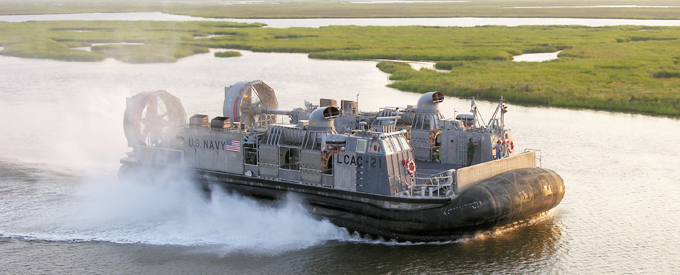2015-09-01
LCAC CORE OF U.S. AMPHIBIOUS PROGRAM
Landing craft Air Cushion (LCAC) mission-proven globally
Textron Systems Marine & Land Systems Landing Craft, Air Cushion (LCAC) is the cornerstone of the U.S. amphibious program and a revolutionary way for the U.S. Navy and Marine Corps to land at more than 80 per cent of the world’s shorelines.
As evidenced by successful relief and combat operations in Haiti, the U.S. Gulf Coast, Malaysia, Somalia, Bangladesh, Liberia, Lebanon, Iraq and Kuwait, LCAC is mission-proven.
Customers are the U.S. Navy and Japan Defense Agency. LCAC is in worldwide use by the U.S. Navy. As evidenced by successful operations in Somalia, Bangladesh, Liberia, Haiti and Kuwait, LCAC is combat-proven. It has also proven invaluable in times of disaster, including tsunami and hurricane relief operations.
The LCAC can traverse snow, marsh, ice, tundra and sand. Traveling at 50-knot speeds, LCAC operates at a range of 250 miles while maintaining 10 per cent fuel reserves.
On land, it surmounts obstacles as high as four feet. Designed to function in extreme temperatures, LCAC withstands climates ranging from the Arctic cold to Sahara heat.
Cargo is easily loaded onto the LCAC via the bow and stern ramps, allowing roll-on/roll-off capability. The LCAC transports up to 150,000 pounds (68,040 kg) of cargo while in overload mode. Use of deck tie-down rails ensures stability of heavy loads during transit.
Multimission
Whether operating from the well deck of an amphibious transport ship, through the surf zone or beyond the beach inland, LCAC provides unparalleled over-the-horizon performance.
Beyond its basic mission of transporting personnel and equipment from ship to shore, LCAC has become a multimission craft. As a troop carrier, LCAC can be outfitted with a personnel transport module that carries up to 180 people or troops.
In civil emergencies, its extensive cargo capacity enables delivery of lifesaving supplies and equipment to otherwise inaccessible sites. As a Medevac, LCAC’s speed ensures rapid response and timely extraction.
The first LCACs were delivered in 1984 with a service life design of 20 years. Following decades of fleet service, the LCAC will operate well into the 21st century with markedly improved performance and increased life span due to a Service Life Extension Program (SLEP).
With SLEP, LCAC will continue to define state-of-the-art, with improvements that include an expanded performance envelope; reduced operating and maintenance costs and crew workload; and an extended service life from 20 to 30 years.
Moreover, SLEP allows improvement in combat readiness by aligning systems capability with other U.S. Armed Forces during joint operations. The SLEP program was launched following significant design and development.
Push limits
Marine & Land Systems continues to push the limits of Air Cushion Vehicle design with development of the next-generation LCAC called Ship-to-Shore Connector or SSC. In partnership with the U.S. Navy, the unique center of knowledge at Marine & Land Systems has been employed to refresh the technology in order to design a craft with increased reliability and maintainability, as well as meet the Marine Corps’ increasing payload requirements.
With more than 55 years of combined and proven ACV production and performance, the Textron Systems, L-3, Alcoa and Rolls Royce team has the technology and experience to eliminate risk and successfully deliver the SSC to the US Navy within budget, at weight and on schedule.
The current contract is for the detailed design and construction of an initial SSC test and training craft, with work to be completed in 2017, and includes options for up to eight production craft to be delivered by 2020 worth a total potential value of $570 million.
The next generation SSC will replace the Landing Craft, Air Cushion (LCAC), providing a modernized means for the U.S. Navy and Marine Corps to land at more than 80 percent of the world’s shorelines. SSC will project and sustain military operations from the sea, independent of tides, water depth, underwater obstacles or beach gradient.
Collaborative experience
The Textron Systems team brings together extensive collaborative experience in engineering, design, specialty materials, systems integration, manufacturing, high-rate production and service life extension with the only facility in the world that has successfully produced 10 SSC-like craft per year – Textron Systems, Marine & Land Systems shipyard.
Located on the Gulf of Mexico, Textron Systems, Marine & Land Systems’ 600,000-plus square-foot shipyard is not your ordinary shipbuilding facility. Specially designed to optimize the production of Air Cushion Vehicle materials, the concept of this unique platform is based on years of experience and proprietary research that streamlines the construction process with a highly efficient assembly station configuration that cuts time and effort by consolidating production. When these craft are finished, they roll off the assembly line and right into open water, mission ready.
Reference
Text/Photo: Textron Systems


No Comments